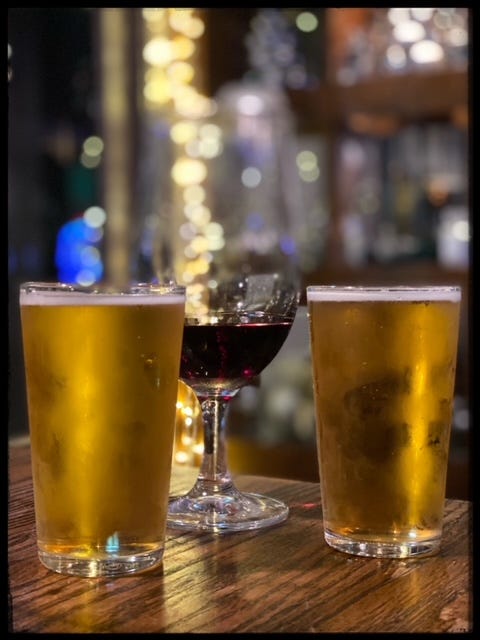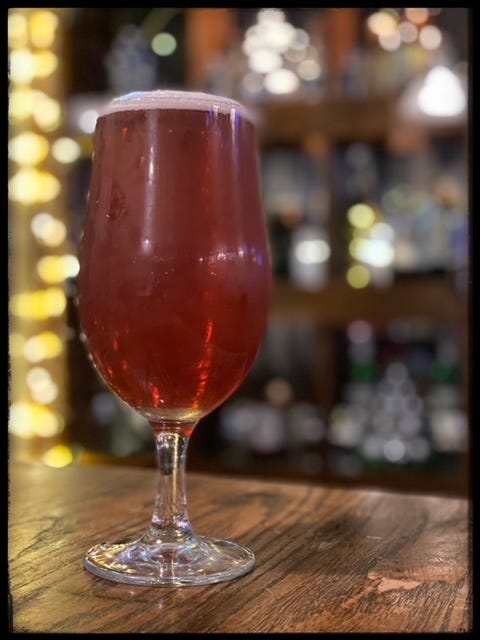A story in three acts – Apples, Grains and Yeast
Act 1 – A #BabyBrit embarks on a quest to investigate an idea, oh and there are loads of no and low alcoholic ciders
As one of the UK’s newest Pommeliers – eeeekk!- I am on a personal mission to discover the alcoholic cider-beer-mixture that is known as snakebite.
Up until the day I travelled to London Town a mere cider drinker and Youngling, returning home, a Padawan, having successfully passed the Initiate Trials, eager to learn more about the world of cider, not one of those weird concoctions of fermented grain and fruit had passed my lips. But, on that faithful day, the husband took me to a pub, and ordered a snakebite for me, in an exchange that went something like this:
Husband (sheepishly): Hi – do you know what a snakebite is?
Bartender (confused and somewhat worried): Yeah? But…
H: Are you allowed to sell us one?
B: Well, kinda – you would have to mix it yourself, I can only sell you two half’s
H: OK, let’s do that
B: What lager do you want?

And there, right in front of me, I watched the building blocks of the latest offence on my taste buds being poured into two half pint glasses.
I had been sipping on some of the greatest locally and internationally produced ciders during my interview, trying to discern what the liquids in the wine glasses may actually be, so watching the golden liquids pouring out the taps into the two nonik glasses seemed worlds away from my morning.
Legend has it, a snakebite ought to be made of equal measure of, and I shall quote the husband here “cooking cider and cooking lager”. The obvious question now, or maybe it is just me, how is cooking cider and cooking lager defined?
I mean, I have used the expression haphazardly without really thinking about it in the past.
I have cooked with beer and cider to impart certain aromas and flavours into the dish. But this idea of cooking doesn’t seem to lend itself to the intended connotations of perhaps more budget friendly.
So, I don’t think the husband implied this. The cooking must therefore refer to something akin to cheap, perhaps mass-produced swirl, not really worthy of being referred to as simply cider or beer. But hey, that’s semantics and perhaps not the way forward either.
With no global cider definition in existence as such, cider can, and is, interpreted in many way, but for sake of this piece we’re going with the Alcoholic Liquor Duties Act 1979 definition of cider as:
“[…] ‘cider’ of a strength exceeding 1.2% alcohol by volume […] but less than 8.5% ABV obtained from the fermentation of apple or pear juice without the addition at any time of any alcoholic liquor or of any liquor or substance which communicates colour or flavour […] necessary to make cider […]”[i]
Likewise, and for good measure really, we can also take CAMRA’s description “[…] real Cider […] being fermented from the whole juice of fresh pressed apples […]”[ii] into consideration.
So, basically cider is fermented apple juice. What about lager?
The Oxford Companion to Beer defines lager as “one of two overarching families of grain-based beverages that comprise “beer.” […] come[ing] in a wide variety of flavors […] opaque, almost black, chocolaty […] smoked […] thick, heavy, sweetly malty […] amber […] deep golden rustic […] golden aromatic […] straw blond and malty […] blond, hoppy, spritzy […] and very thin and light quaffing […] usually mass-produced with adjuncts. […] [with] approximately 9 of 10 beers consumed around the globe [being] lagers. […]”[iii]
The BJCF offer the following: “[…] The most general categorization of beer styles by yeast type is a modern craft brewing phenomenon. American brewers and most other craft brewers call beers […] lagers if they use bottom-fermenting (lager) yeast. […]”[iv]
Unsatisfyingly, yet not unsurprisingly, no mention of cooking in any of the definitions… Maybe, I’m just getting to tangle up in definitions…
Back to the pub:
The cider[v] option of the evening was Inch’s Medium Dry (4.5% ABV) described on their website as “a lightly sparkling cider with a fresh apple aroma – perfect for sunshine sipping. […] [made] using 100% British apples”.
For the beer, the husband and bartender suggested Carling Original Lager (4% ABV), describe on their site as: “The UK’s No.1 Lager [2017], brewed with 100% British barley. It’s perfectly balanced, with a great refreshing taste”
So, a sparkling-perfectly-balanced-fresh-apple-aroma-with-refreshing-taste concoction?!
We are off to a good start here: British apples and British barley for my first Wikipedia-infamous[vi] British drink seems legit.

What doesn’t seem to be too clear or indeed legally allowed however was the actual purchasing / selling scenario: Are you allowed to sell us one? Sorry what? Why wouldn’t I be able to buy a snakebite? Confusion arose inside me.
The husband had mentioned of such rumours before, hinting what the internet called #1 The Snakebite Myth[vii]: Serving Snakebites is illegal in the UK.
Well, no. That is not true actually. Sorry.
You can legally ask for and get a snakebite without fearing you would be arrested if you do so. There is a caveat though: you cannot lawfully get a half pint sized snakebite if you’re ordering cider and beer on draught. The smallest measure you can get your hands on is a 2/3 pint. This is down to our law, which stipulates that cider and beer, if sold by the glass, must be sold in “fixed sizes known as ‘specified quantities’”[viii], precisely in a 1/3, a half, 2/3 of a pint and multiples of half a pint.
So, with that cleared up, a pub or bar may still refuse to sell the drink however – it is certainly their prerogative. They cannot however claim that it is illegal, as this urban myth is nothing more than that – a myth.
Reasons behind an establishment’s refusal can be plenty, but one thought that Pete Brown has put forward is “the drink’s reputation and its tendency to attract undesirable drinkers, particularly in a climate of concern over binge drinking” [ix]may be the root cause.
During some light conversation over a posh packet of salt and vinegar crisps later in the evening, I discover why the reputation precedes this alcoholic mixture: a few pints can get you sozzled while still being relatively budget friendly. So, if you’re looking after your pennies and want to get inebriated at the same time, a snakebite may just seem a bit more tasteful than the no-name brand of high-strength, low-cost white cider. As a result of a said conversation, I now have it on good authority that 3 or 4 pints of snakebite can get you in the right mood for a night out. And somehow Pete’s comment makes even more sense: binge drinking to get intoxicated, not drinking for enjoyment of the liquid consumed.
I can neither confirm nor deny that I ever drunk alcohol purely to get intoxicated. But, if I had/ hadn’t, I would have / wouldn’t have chosen a pink alcopop. So maybe the hypothetical alcopop is my snakebite equivalent. After all, you could (so I have heard, obviously) purchase those drinks with certain BOGOF[x] or equivalent deals, resulting in more boozing for less money.
Oh, and let’s all remind ourselves here: You do not, and I repeat do not, mess with our Apfelwein[xi], let alone German Pils. Another clue why I perhaps never had the dis/pleasure of consuming snakebites for kicks.
As I carry my two half’s to a nearby table, the husband carrying his pint of locally brewed bitter and empty glass for me, I am equally excited and appalled by my determination to be initiated into this part of British pub and drinking culture, almost four years after becoming a #BabyBrit.
And then it hit me: it felt wrong pouring two golden fizzy liquids into another larger glass… why did this feel so immoral, like purchasing the secret plans to world annihilation of a super villain?!
The husband, clearly sensing my troubles, took charge and poured it for me. “You need to pour it in the right order, otherwise it just fizzes over” – clearly speaking from experiences, yet somehow not being able to hide his dislike “I haven’t had or smelt one of those in ages….”
Experiencing wonder, disdain and exhilaration in equal parts, I lifted the glass to my face.
From a drinkers point of view, can the inexpensive allure of perceived quicker intoxication really be the goal of this liquid concoction? Wouldn’t a separate half pint of cider and lager drunk sequentially transport the consumer to the same seeming alcoholic bliss?
Far too many hypothetical questions for a Friday night whirl around my head.
I have been talking about the allusive snakebite for some time now, specifically mentioning that I will have my first one when I become a pommelier.
…which is obviously what one ought to do when the authority on cider, the @Ciderologist Gabe Cook himself, deems your passion and knowledge to be worthy of this “ultimate accolade in cider advocacy”[xii]
So, believing in the power of deduction and discovery, I approach my conundrum with a more scientific approach – let’s have a no/low snakebite and figure out if the alcoholic element is the make-or-break- component after all.
Obviously, there are many options of both cider and lager available, so where does one start? I travelled to through the NoLow Orchard before, subsequently I know that there are some gems out there and I am aware that might struggle to decide which ones to use. …sigh…
And, on the lager front?
I raid my shelves and discover some wonderful #nolo tinnies and bottles, in order of picking them up from the shelf we have:
Low and no alcoholic cider:
Sheppy’s, Low Alcohol Classic Cider (0.5% ABV)
Thatchers, Zero Alcohol Free Cider (0% ABV)
Westons, Stowford Press Low Alcohol (0% ABV)
Crafty Nectar x Wise Bartender, Cider (0.5% ABV)
Adnams, Wild Wave Low Alcohol Cider (0.5% ABV)
Drynks, Smashed Cider (0% ABV)
Low and no alcoholic lager:
Coba Maya Cerveza, Big Drop (0.5% ABV)
Uptown, Big Drop (0.5% ABV)
Classic, Clausthaler (0.5% ABV)
Flat Tire, Pistonhead (0.5% ABV)
Smashed Lager, Drynks Unlimited (0% ABV)
Lost AF, BrewDog (0.5% ABV)

So, thirty-six possible snakebite combinations. Thirty-six potential success stories or indeed failures… I begin to think I may have bitten off more than I can chew here…
The obvious choice here would be to throw all ciders into one hat and all lager into another and then let Lady Luck pair them up… or you could try mixing each cider with each lager…
Back in the pub, I inhale the aromas of my first ever snakebite deeply, before I take a closer look:
Eyes: Pours a hazy deep gold, white smooth head, lacing present, moderate carbonation.
Nose: On the nose clean and somewhat yeasty, hints of fruity apple juice, ghosts of baked apples in the background.
Well, let’s try it, shall we?
Palate: On the palate clean, then somewhat papery, a flavour which disappears as quickly as it appeared a second ago. Apples swoop in, before a clean quick dry-ish lager finish ends the experience in a somewhat cloying, but not lingering aftertaste.
I am puzzled by this taste experience – what is this sorcery?
I may have uttered “I think I like it” with the emphasis being on think: I honestly am not sure what to make of it and look over at the husband, an old hand at snakebite imbibing, some guidance.
He, on the other hand, is looking at me in vain attempts to read the expression on my face “And? What do you think?”
Act 2 – Exploring further: Hic sunt bigeneri – Here be Hybrids. Discovering Big Dragon Energy and Dainty Damsel Vibes
Leaving the No/Lo Orchard behind me, I look across its fence into the wider landscape of drinking cider-and-beer-mixtures. Oh boy, have I found a rabbit hole or what?!
Distinguished reader – I present to you – Graf/f
Fictionally born[xiii], made a reality by craft beverage creators, home brewers and cider makers, Graf/f is a cider-beer hybrid, or an apple-based beer, or well, to be honest, anything rather vague described as either a cider-beer or a beer-cider hybrid, depending on whether I was looking at cider or beer resources. The jury is also still out as to whether the drink was inspired by modern fiction, or if makers and brewers arrived at versions of the drink through pure experimentation. It is frustratingly yet defiantly elusive. What is certain is that this concoction contains both fermented apple and fermented grain somewhere along the way.
So overall, Graf/f is a vaguely defined craft style, with an evidently smaller marketing budget than let’s say Cyser[xiv] or Braggot[xv]… and yet, some commercially available examples exist. Additionally, other somewhat related iterations are available too, I might add. And, because they do, I obviously had to sample some. The husband joined in reluctantly.
Yes, I see and hear you Dear Reader, Graf/f is not a snakebite, but I am taking the liberty to follow the white rabbit down this hole, and this is where it is taking me.
Exploring the world through the lens of cider has opened my eyes to many experiences I would have previously dismissed. Perfectly executed apple and grape co-ferments, for example, are increasingly pushing me towards Wine Town, an expedition seemingly intolerable before. So, who knows what awaits me around the corner?
Little Earth – Crab apple sour 2020 (4.8% ABV)
Macerated BA Sour [xvi]
Aeblerov (Warpigs collaboration) – Både& #4 (5.9% ABV)
Cider/beer Hybrid”[xvii]
Aeblerov – Hyper cider 2020 (6.2% ABV)
Cider/wine/beer Hybrid”[xviii]
Little Earth – Hard Graf (6.3% ABV)
Graff / Cider/Saison Blend”[xix]
The Bruery – Anxoreux (7% ABV)
Apple Ale”[xx]
Oliver’s X Mills Brewing – Foxbic Four (7% ABV)
Graff / BA Lambic beer & Cider blend”[xxi]
So, we have two cider and beer hybrids, two cider and beer blends, an apple ale and a sour beer which has undergone lengthy maceration of apples.
It is no secret that I am massively invested in co-ferments at the moment – huge win for me!
I recently had the most wonderful blonde wild ale re-fermented on Riesling grapes … yes, you read that correctly – fermented on crushed wine grapes. Mind you, if I was to enjoy a wine, it might as well be from grapes with a German heritage, closely resembling my own
(I think I got away with this one ….)
Co-Ferments are inclusive and non-discriminatory: you can get your paws on cider-wine hybrids, cider-sake and beer-wine co-ferments, and indeed cider-beer hybrids.
As such, none of the drinks listed above would or should be classed a classic British snakebite[xxii]:
A co-ferment is typically a beverage where the yeast ferments sugars in more than one ingredient to create alcohol, so for example the sugars in the apple juice and in the wort simultaneously. A re-ferment is a beverage where one liquid has already undergone a fermentation process, is then mixed with another (containing the required sugar) and left to ferment again.
As such, wort may be rested on crushed apples or grape skins, this can also be referred to skin-contact or maceration, and is indeed used in the winemaking process, or a cider-to-be is mixed with grape-juice before fermentation begins. Some hybrids may also be fermented as a cider or beer for example, and then re-fermented with skin contact, known as the mentioned re-ferments. The possibilities are endless really, but none of those options should be considered snakebites in the traditional sense.
First of all, a typical snakebite is a 50:50 mixture and not blend. In a classic cider, beer or wine blend, the harmony of the liquids to be combined is key, paying attention to the individual aromas and taste components of the liquids, to create something bigger than the sum of its parts.
Secondly, the mixing of liquids happened pre- and during fermentation, while a snakebite is mixed (myth preventing) by the consumers themselves post-fermentation.
But then, the definition of a snakebite is equally as vague, merely resting on the commonly agreed concept of half-cider-half-beer. So, a 50:50 stout and cider combo equally conceivable, and if poured in the right order, visually interesting.
Give yourself to the Dark Side[xxiii]

And that is exactly what I did back in the pub: The husband ordered a Snakebite and Black for me… you know, to get the full experience and that….
Eyes: Pours a dark hazy pink, pink smooth head, lacing present, moderate carbonation.
Nose: On the nose clean and very fruity, almost too artificial, reminds me of hibiscus, blackberries and maybe even sweet overripe raspberries
Palate: On the palate clean and sweet, almost cloying, but carbonation helps to lift the sweetness of the tongue, almost impossible to pick apart, flavours of fruity berries mingle with some notes of apple and grain… almost like a fruits of the forest jam sandwich, but not quite…
Did this initiation into British drinking culture come too late for my palate? Or perhaps too soon?
And, bless him – the husband is clearly not sure what to make of the scenes unfolding in front of him: should he be worried? Proud? Confused… why dissect a snakebite when it is meant to be chugged? Or is it? The perplexity of the situation grew into an almost uncomfortable monster: do I like it or not??
Give yourself to the Dark Side[xxiv] “Do. Or do not. There is no try.”[xxv]
Act 3 – Crossing over to the Dark Side of the Force and why I find your lack of faith disturbing[xxvi]
Well, actually there is no Act 3, I just wanted to quote Darth Vader – I mean, who can blame a girl?!
I guess, you may also wonder how I got on with my no/lo snakebites and the hybrids. If you are, fear not, I will indeed post my experiences soon. This is literally just the beginning of my journey as a Pommelier hunting down snakesbites where I can. If you’re not fully involved in this quest, no worries.
Anyway, needless to say, Darth Vader makes a precise good point: the very notion of ordering and drinking a snakebite in public may be laced with preconceptions about the drink, the people drinking it and the drinking culture surrounding it. Why no faith people?
Aren’t we allowed to order a drink we like to enjoy? Whether this is indeed a crisp lager, a fruity cider, or indeed a snakebite, no one but me knows what I enjoy. I don’t consider you less of a person if you like red wine over white wine, or if you rather order a Polish wódka Polish over Swedish vodka. I don’t dislike you if you enjoy sparkling cider from Gala apples instead of bone dry still cider made exclusively from Dabinett and Kingston Black. What I care about when I drink with you, is, that you enjoy the liquid in the glass, and you drink responsible! Flaming Sambucas your thing? Go for it, but don’t make me hold your hair later on that evening – been there done that and got the hangover.
The culture around consuming alcohol has changed. Granted people still binge drink their way to hangovers, but we are now more aware of the dangers alcohol can bring.
I may be talking specifically about my generation here, but I suspect this is true for most of us: We don’t just chug the booze to get obliterated, most of us want to taste what is in the glass. We want to know why things taste like they do. We have no time for bad drinks.
Well, sorry – disclaimer time: I have no time for bad drinks. I should not generalise.
A girl can hope though, right?! And, maybe we all need a little bit of faith when it comes to the marriage of lager and cider – is it horrible? Is it great? That’s for you to judge. All I can say is, that I have learned a little bit more about what kind of drinker I am during this journey, and that’s all that matters to me at the moment.
And, with that bolt out of the blue (clearly no one saw this coming, amirite?), I shall love and leave you!
Macht’s euch fein!
Wassail
xxx
[i] Gov.co.uk Excise Notice 162: cider production https://www.gov.uk/government/publications/excise-notice-162-cider-production/excise-notice-162-cider-production [Accessed 06/12/22]
[ii] Campaign for Real Ale. UK Learn & Discover What are real cider & perry? https://camra.org.uk/learn-discover/the-basics/what-are-real-cider-perry/ [Accessed 06/12/22]
[iii] The Oxford Companion to Beer, 2013 Online Version, lager https://www.oxfordreference.com/view/10.1093/acref/9780195367133.001.0001/acref-9780195367133-e-731?rskey=NWKyXP&result=1 [Accessed 06/12/22]
[iv] Beer Judge certification Program 2021 Beer Style Guidelines with 2015 Mead and Cider Style Guidelines and Special Ingredient Descriptions https://www.bjcp.org/download/2021_guidelines_consolidated-pdf [Accessed 06/12/22]
[v] HP Bulmer Limited, Inch’s Medium Dry Apple Cider https://www.inchscider.co.uk/product [Accessed 30/11/22]
[vi] Wikipedia, the free encyclopedia, Snakebite (drink) https://en.wikipedia.org/wiki/Snakebite_(drink) [accessed 30/11/2022]
[vii] Loz Horan, #1 The Snakebite Myth, August 20, 2013, via The Internet Archive Wayback Machine https://web.archive.org/web/20131031031313/http://www.delavals.com/category/blog-loz-horan/ [Accessed 30/11/2022]
[viii] Gov.co.uk Weights and measures: the law https://www.gov.uk/weights-measures-and-packaging-the-law/specified-quantities [Accessed 30/11/2022]
[ix] The Oxford Companion to Beer, 2013 Online Version, snakebite
https://www.oxfordreference.com/view/10.1093/acref/9780195367133.001.0001/acref-9780195367133-e-1037?rskey=JT8IeQ&result=1001 [Accessed 30/11/2022]
[x] BOGOF = Buy One Get One Free
[xi] Correction: We do mix Apfelwein (and indeed Pils) with various other liquids, from sparkling mineral water, lemonade and coke, and yes, the husband is correct in reminding me that Germans even mix it with Red Bull, but I have not come across it being mixed with a lager (or Apfelwein)… so for now, I shall claim pure ignorance here!
[xii] The Ciderologist Beer & Cider Academy: Pommelier Assessment https://www.theciderologist.com/products/pommelier-assessment [Accessed 01/12/2022]
[xiii] Persuit of Hoppiness Peckhams X Cell Division Fire Graff, by Michael Donaldson. Published on Friday 16 July 2021. https://hoppiness.co.nz/peckhams-x-cell-division-fire-graff [Accessed 05/12/22]
[xiv]Viking Alchemist Meadery What’s the Difference Between Mead, Cyser, Braggot & Melomel? https://www.vikingalchemist.com/mead-blog/2020/1/28/whats-the-difference-between-mead-cyser-braggot-amp-melomel [Accessed 05/12/22]
[xv] Ibid.
[xvi] Cambridge Wine Merchants Little Earth Project Crab Apple Sour 2020 https://www.cambridgewine.com/shop/products/beers-and-ciders/fruit-beers/little-earth-project-crab-apple-sour-2020-4-8-37-5cl-bottle.html [Accessed 06/12/22]
[xvii] Æblerov Både& #4 (Warpigs collaboration) https://www.aeblerov.com/shop/bdeamp-4-warpigs-collaboration [Accessed 06/12/22]
[xviii] Æblerov – Hyper Cider https://www.aeblerov.com/shop/hyper-cider [Accessed 06/12/22]
[xix] Cambridge Wine Merchants Little Earth Project Hard Graf https://www.cambridgewine.com/shop/products/beers-and-ciders/cider/little-earth-project-hard-graf-6-7-75cl-bottle.html [Accessed 06/12/22]
[xx] The Bruery ANXOREUX https://www.thebruery.com/products/anxoreux-750ml [Accessed 06/12/22]
[xxi] The Cat in the Glass Oliver’s X Mills Brewing – Foxbic Four https://thecatintheglass.co.uk/product/olivers-x-mills-brewing-foxbic-four-750ml/ [Accessed 06/12/22]
[xxii] Here I am relying on the husband’s definition of snakebite as a 50:50 lager:cider creation.
[xxiii] Darth Vader in Star Wars: Episode VI – Return of the Jedi (1983)
[xxiv] Ibid.
[xxv] Yoda in Star Wars: Episode V – The Empire Strikes Back (1980)
[xxvi] Darth Vader in Star Wars: Episode IV – A New Hope (1977)

Leave a Reply